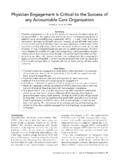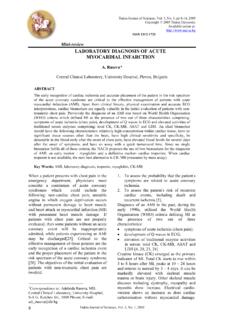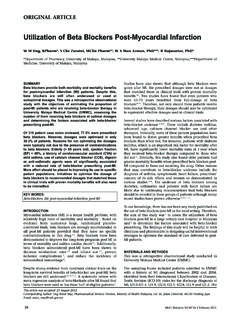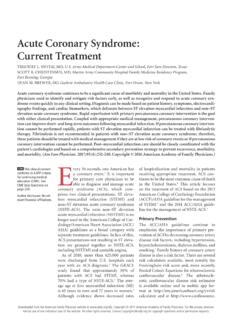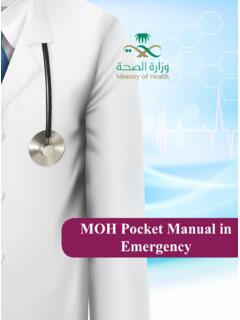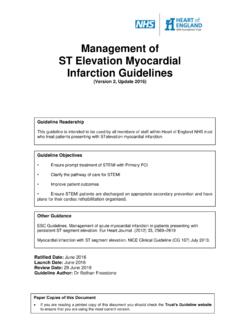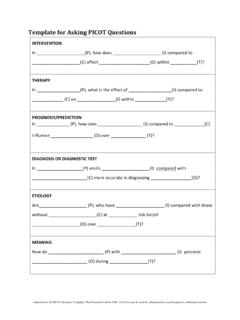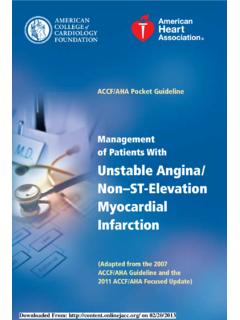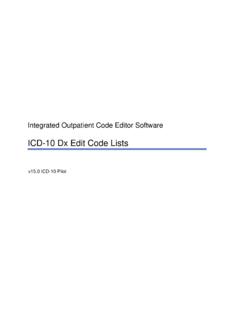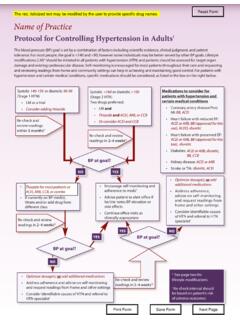Transcription of JMCM V9N4 Role of Beta-Blockers for the Post-Myocardial ...
1 Role of Beta-Blockers for the Post-Myocardial Infarction Patient with Left Ventricular Dysfunction Gregg C. Fonarow, MD. Summary Beta-Blockers significantly decrease the risk of reinfarction, heart failure, and mortality in patients after myocardial infarction (MI). Guidelines recommend that post -MI patients should be started and continued indefinitely on beta-blocker therapy, unless absolutely contraindicated or not tolerated. Patients with post MI left ventricular dysfunction are at particularly high risk for recurrent events and mortality. These patients have been shown to derive substantial benefit from certain Beta-Blockers . Key Points Despite compelling evidence, many patients are not prescribed Beta-Blockers after a myocardial event. Additionally, some patients are treated with agents whose long-term use has not been shown to be effective.
2 This paper will discuss the clinical trial evidence supporting the use of beta- blockers , provide the rationale for choosing specific Beta-Blockers , and present practical approaches to implement this evidence-based therapy in the acute and chronic post -MI period. MORE THAN 1 MILLION PATIENTS SUFFER (systolic blood pressure <80 mmHg), signs of a myocardial infarction (MI) in the United States each peripheral hypoperfusion, cardiogenic shock, acute Despite significant advances in pharmacologic and pulmonary edema, advanced heart block (without interventional therapies, 25 percent of men and 38 pacemaker), or reactive airway ,3. percent of women still die within one year of an acute The 2004 American Heart Association/American MI. In addition, nearly half will experience subsequent College of Cardiology (AHA/ACC) STEMI guidelines physical disability from heart failure (HF).
3 1 Prognosis give a Class Ia recommendation (procedure/treatment after an MI is determined by several factors including should be performed/administered) for the in-hospital the extent of left ventricular systolic dysfunction (LVD) and long-term post discharge use of Beta-Blockers in (a left ventricular ejection fraction [EF] of less than or MI (ST elevation MI [STEMI]) patients without equal to 40 percent) with or without clinical HF; the The presence of decompensated progression of underlying coronary artery disease heart failure early in the course of STEMI should (CAD); patient age; and comorbidities. These factors preclude the use of early IV beta-blockade until the lead to death due to progressive HF, sudden arrhythmic HF has been compensated, but LVD and/or HF is a death, and reinfarction.
4 Randomized clinical trials have strong indication for the oral use of beta-blockade shown that long-term beta-blocker use reduces the before discharge from the The 2002. risk of death and disability in MI survivors. Current ACC/AHA guideline update for the management of guidelines state that all patients should be prescribed patients with unstable angina and non-ST-segment a beta-blocker after an MI unless there is an absolute elevation myocardial infarction supports the use of contraindication to therapy. Contraindications beta-blocker therapy as a Class Ib include symptomatic bradycardia, hypotension Despite compelling evidence and recommendations, | Vol. 9, No. 4 | Journal of Managed Care Medicine 11. Beta-Blockers remain an underutilized therapy in the The recent large-scale Clopidogrel and Metoprolol post -MI period.
5 Physician concerns may exist regarding in myocardial Infarction Trial (COMMIT) showed no the safety and benefits of Beta-Blockers in post -MI mortality difference with the use of IV beta-blockade, patients with LVD, with or without HF symptoms, supporting the weaker recommendation previously despite clinical trial evidence to the contrary. This is made by the ACC/AHA In this study, especially important as many post -MI patients will have 45,852 patients were randomly allocated metoprolol LVD with or without symptoms of HF. In the (up to 15 mg IV, then 200 mg oral daily; n=22,929) or Trandolapril Cardiac Evaluation (TRACE) registry matching placebo (n=22,923), and study treatment involving more than 6,500 MI patients, HF and LVD was to continue until discharge or up to four weeks in were assessed within the first few days of an MI.
6 This hospital (mean=15 days in survivors). Eligible patients study found that 64 percent of post MI patients had either included those presenting with ST-segment elevation, HF or LVD, or ,6 In addition, misunderstandings left-bundle branch block, or ST-segment depression (7. may persist regarding the safety and benefits in elderly percent) within 24 hours of onset of symptoms of patients or patients with diabetes or chronic obstructive suspected acute MI, unless their physician considered airway disease. A number of Beta-Blockers have them to have clear indications for, or contraindications demonstrated safety and efficacy in large-scale, long- to, any of the study treatments. Patients scheduled for term,placebo-controlled,randomized clinical trials of MI primary percutaneous coronary intervention (PCI).
7 Survivors in which the target doses were well were excluded. Other reasons for excluding patients Nevertheless, MI patients are often treated with agents were determined by the physician and included either whose long-term use has not been shown to be effective a small likelihood of worthwhile benefit ( , other and for which optimal dosing has not been ,11 life-threatening disease or unconvincing history of MI) or high risk of adverse effects with the study Risk after myocardial Infarction treatments (which for metoprolol would have Within six years of a myocardial infarction, approx- included persistently low blood pressure [ , systolic imately 18 percent of men and 35 percent of women blood pressure below 100 mm Hg], or low heart rate will have a recurrent MI.)
8 post -MI patients also have a [ , below 50 bpm], heart block, or cardiogenic sudden death rate that is four to six times that of the shock). Evidence of moderate HF (Killip class II or III). general Compared with post -MI patients was not an exclusion criterion; approximately 20. without LVD, patients with LVD have an even worse percent of patients were in Killip class II and almost 5. prognosis. post -MI patients with LVD have a fourfold percent were classified as Killip class was no increase in the rate of in-hospital mortality and a twofold difference in overall mortality between the placebo to threefold increase in the rate of mortality at 30 days and metoprolol groups (RR=1 percent, P= ). Of and at 6 post -MI patients with LVD also importance, patients in this study had a significantly have a twofold increase in the rate of reinfarction and are increased risk (30 percent, P< )
9 Of cardiogenic at the highest risk for sudden ,13 Approximately 50 shock when administered IV metoprolol followed by percent of patients with LVD do not have symptoms of oral metoprolol succinate versus HF, but despite being asymptomatic they remain at similar risk as patients with symptoms of Intermediate and Long-Term post MI Period Long-term beta-blocker therapy has been associated Beta-Blocker Use after myocardial Infarction with significant mortality reductions in MI patients as Immediate post -MI Period demonstrated in three large-scale, randomized, clinical Beta-blocker use in the immediate post -MI period is trials: the Beta-Blocker Heart Attack Trial (BHAT),7,23. a Class I recommendation in the AHA/ACC guidelines. the Norwegian Timolol Trial (NTT),8 and the The use of intravenous beta blockers is a Class IIa Carvedilol post -Infarct Survival Control in Left Some, but not all, trials of beta- Ventricular Dysfunction (CAPRICORN)9 trial blockers in the early stage after an MI have shown a (Exhibit 1).
10 Although HF or LVD is present in a large reduced risk of reinfarction, arrhythmias, and number of MI patients,6 individuals with significant Beta-Blockers are believed to limit the cardiac decompensation have generally been excluded damage to the injured Meta-analysis of from randomized -blocker trials: only 19 percent of clinical trials have demonstrated that immediate BHAT and 33 percent of NTT participants had a (within 24 hours) post -MI -blocker use can provide history or some degree of HF on ,23 In reductions in all-cause mortality; however, these agents BHAT, patients with a history of severe HF were remain unproven in reducing nonfatal ,18- excluded, and in NTT, patients with uncontrolled 21. Most of these trials were conducted before the use of cardiac failure were ,8 CAPRICORN.
